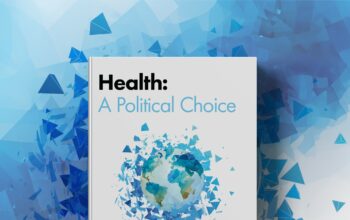Dose sharing is a critical urgent step towards vaccine equity: it needs support to be successful (Step #1)
Step 1 of the biopharmaceuticals 5-step plan to address vaccine equity
A number of countries with access to sufficient doses to vaccinate their own populations have pledged 1 billion doses so far for low- and middle-income (LMIC) countries in 2021 and 2022. We now need to ensure those pledges are realized and vaccines reach those who need them most.
The good news is there are increasingly more doses available. Not least because the global biopharmaceutical industry is on track to produce at 11 billion doses by the end of 2021. If shared equitably, that’s enough to vaccinate most of the world’s entire adult population.
To make sure these vaccines reach the people who need them, collaboration between governments, industry and other stakeholders is needed to plan the orderly distribution of the vaccines – spread out in such a way that countries receive the first shared doses as soon as possible and not all at once at the end of 2021.
The logistics of the vaccine rollout is complex. Let’s not forget, this has never been done before on such a scale. The complexities of delivering to billions of people in urban as well as in more remote settings are manifold, and all against the ticking clock of vaccine shelf life.
Planning
The key to ensuring dose sharing delivers on its promise of equity goes far beyond pledges. It’s about having all the necessary information to understand what needs to be done, by who and when. The sooner there is clarity on when the earmarked doses will be available and where they will make the greatest impact, experts along the whole chain can spring into action.
We need to deliver doses in a reliable and predictable way. We need to track progress to tackle and learn from bottlenecks. We need to work together as one.
Five-Step Plan
We know that action is needed in five areas to advance COVID-19 vaccine equity:
- Stepping up dose sharing;
- Optimizing production;
- Eliminating trade barriers;
- Supporting country readiness;
- Driving further innovation.
These steps are interdependent: for dose sharing to be successful, we need to progress on all steps at the same time.
So where are we now and what do we know? There is good news as a number of important announcements have been made.
G7 countries have pledged 1 billion doses for poorer countries, primarily through COVAX, with over half of these doses due to be delivered in 2021. Deliveries from France are already underway. The US also announced a donation of 500 million doses of the Pfizer-BioNTech vaccine, provided by Pfizer-BioNTech at a not-for-profit price. In addition, at the recent G20 Global Health Summit, vaccine manufacturers pledged to supply 3.5 billion doses of COVID-19 vaccines in 2021 and 2022 for low and middle income countries at cost or discounted to COVAX and other established mechanisms, in addition to the 800 million doses pledged earlier.
We need to drill down to fully understand how quickly these pledges will be fulfilled and how quickly doses can be rolled out, and get jabs into arms. 515 million doses have been pledged for 2021, and according to the latest forecast they should start becoming available in significant numbers very soon and then to be relatively evenly paced through the year[1]. But we know that the forecast will continue to evolve as we know technical issues, regulatory processes, delivery constrains could have an impact on supply schedules.
All these developments, with hopefully more to come, are encouraging as we work towards global vaccine equity. But there are likely to be bumps in the road, simply because we are all doing something that has never been done before.
Accelerating Roll-Out
Dose sharing remains an extremely complex global undertaking with high stakes. Manufacturers need to accelerate production working with hundreds of partners around the world and dispatch at speed while fulfilling all regulatory and legal requirements. They must maintain a laser-like focus on the supply chain to guarantee the quality and safety of all vaccine batches. Governments need to smooth the path for vaccines to enter their countries, while protecting their citizens. Regulatory bodies need to ensure safety, accountability, and process.
If donated doses are to reach the people they are intended for, government, industry and other stakeholders need to collaborate to address these complex and interconnected challenges.
Addressing Deployment Gaps
Once doses have been donated, if they are to reach populations at risk, relevant organizations and programs need to assure financing and support to governments to enhance their vaccine distribution capacities. The timeline of deliveries should also be informed by the countries’ absorption capabilities. All countries face challenges rolling out massive vaccination campaigns, but LMICs particularly will face an intense pressure over the coming months. So knowledge sharing is vital as those countries that have successfully implemented inoculation programmes have critical know-how and technical support to give.
And the clock is ticking. The more time lost getting the logistics sorted, the greater the risk of doses going to waste. According to WHO AFRO, twenty-three African countries have used less than half of the doses they have received so far. About 1.25 million AstraZeneca doses in 18 countries must be used by the end of August to avoid expiration.
Unfortunately, we see countries having to juggle logistics around thousands of municipalities and local authorities to store and then be ready to administer their doses before they expire. This is why it is important to ensure that the donated doses are spread out over time, on a continued, rolling basis.
It is critical to build capacity to effectively store, distribute, and administer vaccines. And while doses are donated, the rest of the process needs to be budgeted to cover the costs of:
- Developing national vaccination plans;
- Establishing regulatory vaccine approval and vaccine safety systems;
- Building vaccine distribution infrastructure on the ground, including cold chain capacities;
- Training of staff involved in deployment and delivery of vaccines;
- Strengthen data collection, reporting and tracking systems;
- Addressing hesitancy issues by planning public health campaigns to generate trust and demand for COVID-19 vaccines.
Each of these challenges is a pressing problem in itself. Vaccinating the world against a virulent and deadly disease is a colossal global challenge. Yet the 5-steps plan to advance vaccine equity provides a robust framework to help bring the pandemic under control.
[1] COVAX Global Supply Forecast
Author






